‘Honolulu’ Category
» posted on Friday, June 29th, 2012 by Linda Lou Burton
Girls Just Wanna Have Fun
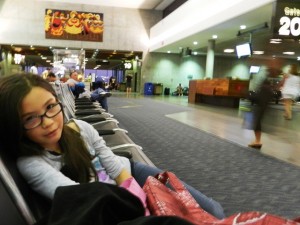 Linda Burton posting from Honolulu, Hawaii – “What was your most fun thing?” granddaughter Kayla asked. We are sitting at Gate 20 in the Honolulu airport, wearing long sleeves now; dressed for Seattle’s cooler temps that will surely shock our senses as soon as we get off the plane. It’s the last moments of our stay in Honolulu, and we’re reminiscing. “Everything was fun,” I answered. “When I could see through my hair blowing in my face.” “Well that was just one day then,” Kayla said, “when we
Linda Burton posting from Honolulu, Hawaii – “What was your most fun thing?” granddaughter Kayla asked. We are sitting at Gate 20 in the Honolulu airport, wearing long sleeves now; dressed for Seattle’s cooler temps that will surely shock our senses as soon as we get off the plane. It’s the last moments of our stay in Honolulu, and we’re reminiscing. “Everything was fun,” I answered. “When I could see through my hair blowing in my face.” “Well that was just one day then,” Kayla said, “when we 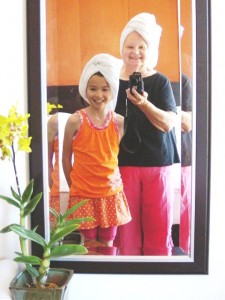 were towelheads in our room!” That brought giggles from both of us, yep, those tropical breezes are part of the attraction in Honolulu, moderating the sun and the warm morning rains. So what was the most fun thing? “I liked the Aquarium today,” Kayla threw in. “And going into Diamond Head.” “You liked the Trolley Driver,“ I said. “Because he kept telling you how cute you are!” It’s true, he’d let her get off the Trolley for pictures, and wait till she was done before resuming the Tour. “She’s so cute,” he’d say when she got back on. “Did you get what you wanted, little one?” She tipped him big, with money out of her own pocket. So Honolulu, what was the most fun? » read more
were towelheads in our room!” That brought giggles from both of us, yep, those tropical breezes are part of the attraction in Honolulu, moderating the sun and the warm morning rains. So what was the most fun thing? “I liked the Aquarium today,” Kayla threw in. “And going into Diamond Head.” “You liked the Trolley Driver,“ I said. “Because he kept telling you how cute you are!” It’s true, he’d let her get off the Trolley for pictures, and wait till she was done before resuming the Tour. “She’s so cute,” he’d say when she got back on. “Did you get what you wanted, little one?” She tipped him big, with money out of her own pocket. So Honolulu, what was the most fun? » read more
» posted on Thursday, June 28th, 2012 by Linda Lou Burton
Yellow on the Submarine
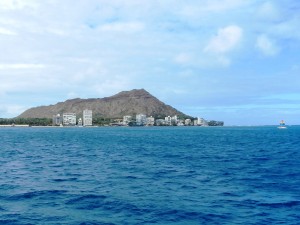 Linda Burton posting from Honolulu, Hawaii – I had the name for this post the minute we booked the tour. I get claustrophobic in caves, so why on earth would I enjoy a submarine? But it was the one thing on the brochure that Kayla picked out, and who can deny, it would be unique. I decided to be brave; after all, I told myself, I do like being ON TOP of the water. And I’ve always liked the adventures of Jacques Cousteau. It could be a good story to tell, later on. But the wind was blowing hard today; our pickup trolley was late; they didn’t have our names on the manifest, although I held the voucher in my hand. Are these warning signs? Should I listen to the Karma of the Day? Kayla was dancing the excitement jig; the coordinator called ahead; nodded at us both; “Just get on,” she said, “we’ll straighten it out when you get to the boat.” Hop on, ride to another hotel, walk the beach walk to the pier, our yellow tickets were ready, slipped into my hand. Yellow! Yikes, another sign? » read more
Linda Burton posting from Honolulu, Hawaii – I had the name for this post the minute we booked the tour. I get claustrophobic in caves, so why on earth would I enjoy a submarine? But it was the one thing on the brochure that Kayla picked out, and who can deny, it would be unique. I decided to be brave; after all, I told myself, I do like being ON TOP of the water. And I’ve always liked the adventures of Jacques Cousteau. It could be a good story to tell, later on. But the wind was blowing hard today; our pickup trolley was late; they didn’t have our names on the manifest, although I held the voucher in my hand. Are these warning signs? Should I listen to the Karma of the Day? Kayla was dancing the excitement jig; the coordinator called ahead; nodded at us both; “Just get on,” she said, “we’ll straighten it out when you get to the boat.” Hop on, ride to another hotel, walk the beach walk to the pier, our yellow tickets were ready, slipped into my hand. Yellow! Yikes, another sign? » read more
» posted on Wednesday, June 27th, 2012 by Linda Lou Burton
A Loverly Bunch of Coconuts
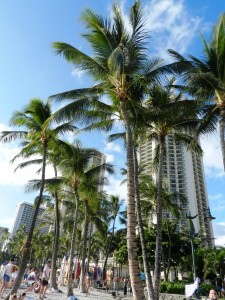 Linda Burton posting from Honolulu, Hawaii – “Thank you, thank you, thank you,” they muttered as we applauded the procession coming towards us on the sidewalk. Ten blond California-stereo guys in grass skirts and coconut bras were catching the attention they sought on the streets of Waikiki, turning heads and generating laughter along the way. A pirate look-alike with a bright green parrot on his shoulder hung out mid-block offering opportunity – Pose with Polly, $10. Just in front of our hotel, a black man in baggy white shorts was turning circles to the count of two passers-by; when he got to 13 they yelled “Jump!” and he did a backflip, barefoot, without falling down. And then collected his tip. Not weird, in this party town, where the sheltering palms seem to attract an odd assortment of coconuts. » read more
Linda Burton posting from Honolulu, Hawaii – “Thank you, thank you, thank you,” they muttered as we applauded the procession coming towards us on the sidewalk. Ten blond California-stereo guys in grass skirts and coconut bras were catching the attention they sought on the streets of Waikiki, turning heads and generating laughter along the way. A pirate look-alike with a bright green parrot on his shoulder hung out mid-block offering opportunity – Pose with Polly, $10. Just in front of our hotel, a black man in baggy white shorts was turning circles to the count of two passers-by; when he got to 13 they yelled “Jump!” and he did a backflip, barefoot, without falling down. And then collected his tip. Not weird, in this party town, where the sheltering palms seem to attract an odd assortment of coconuts. » read more
» posted on Tuesday, June 26th, 2012 by Linda Lou Burton
Wear Your Slippers
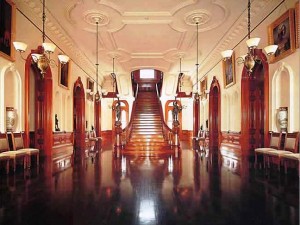 Linda Burton posting from Honolulu, Hawaii – “It’s not for me to reason why,” I grumbled as I tucked my camera in my bag and pulled slippery bootees over my sensible shoes. The Guard Guide continued to bark instructions to everyone. No smile, no aloha warm. Kayla wiggled her feet admiringly, “Baby boots,” she said. Here we sat, on a bench outside the Iolani Palace doors, ticketed for the tour that included “audio,” being sternly lectured as to how we should behave. “Do not take off your slippers. Do not touch anything. Do not get any pictures. There is a button on your wand for each room. Push it when you get there. Now go.” The door opened and the group of us meekly entered the Palace one by one. Highly polished floors stretched ahead in the Grand Hall; I stepped and slid and almost fell. “Be careful GMom,” Kayla warned, “just glide. And turn on your sound.” Both of us pushed Button 2 on the audio wands hanging from our necks, and glided on the shiny floor. The Throne Room was to our left. » read more
Linda Burton posting from Honolulu, Hawaii – “It’s not for me to reason why,” I grumbled as I tucked my camera in my bag and pulled slippery bootees over my sensible shoes. The Guard Guide continued to bark instructions to everyone. No smile, no aloha warm. Kayla wiggled her feet admiringly, “Baby boots,” she said. Here we sat, on a bench outside the Iolani Palace doors, ticketed for the tour that included “audio,” being sternly lectured as to how we should behave. “Do not take off your slippers. Do not touch anything. Do not get any pictures. There is a button on your wand for each room. Push it when you get there. Now go.” The door opened and the group of us meekly entered the Palace one by one. Highly polished floors stretched ahead in the Grand Hall; I stepped and slid and almost fell. “Be careful GMom,” Kayla warned, “just glide. And turn on your sound.” Both of us pushed Button 2 on the audio wands hanging from our necks, and glided on the shiny floor. The Throne Room was to our left. » read more
» posted on Monday, June 25th, 2012 by Linda Lou Burton
Going in Circles
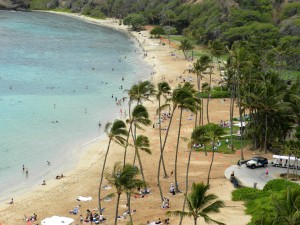 Linda Burton posting from Honolulu, Hawaii – We picked Tour #7, The Grand Circle Island. “See Oahu from Hanauma Bay to the North Shore on a 120-mile trip which includes a visit to Kualoa Ranch and Dole Pineapple Plantation.” That teaser pulled us in; “bay and shore and-pineapple” are key words when you think of Hawaii, and the idea of someone else driving that 120 miles appealed to me. Kayla was gung-ho for everything, we were up and ready to meet the bus out front at 8:30 sharp. She re-read the brochure while we waited. Oahu’s prestigious Kahala area. Hanauma Bay overlook. Halona Blow Hole lookout. Nuuanu Pali Lookout. Byodo-In Temple amidst mountain backdrop. Kualoa Ranch including scenic drive into the Ko’olau mountains overlooking Chinaman’s Hat and Kaneohe Bay. World famous North Shore surfing beaches of Sunset, Banzai Pipeline and Waimea Bay. Dole Plantation and Plantation Gardens. No-host lunch. That’s what the brochure said we’d see. Now I’ll tell you what we saw, as we spent the day on a luxury bus with Driver Don, from Minnesota. » read more
Linda Burton posting from Honolulu, Hawaii – We picked Tour #7, The Grand Circle Island. “See Oahu from Hanauma Bay to the North Shore on a 120-mile trip which includes a visit to Kualoa Ranch and Dole Pineapple Plantation.” That teaser pulled us in; “bay and shore and-pineapple” are key words when you think of Hawaii, and the idea of someone else driving that 120 miles appealed to me. Kayla was gung-ho for everything, we were up and ready to meet the bus out front at 8:30 sharp. She re-read the brochure while we waited. Oahu’s prestigious Kahala area. Hanauma Bay overlook. Halona Blow Hole lookout. Nuuanu Pali Lookout. Byodo-In Temple amidst mountain backdrop. Kualoa Ranch including scenic drive into the Ko’olau mountains overlooking Chinaman’s Hat and Kaneohe Bay. World famous North Shore surfing beaches of Sunset, Banzai Pipeline and Waimea Bay. Dole Plantation and Plantation Gardens. No-host lunch. That’s what the brochure said we’d see. Now I’ll tell you what we saw, as we spent the day on a luxury bus with Driver Don, from Minnesota. » read more
» posted on Sunday, June 24th, 2012 by Linda Lou Burton
Aloha is Love
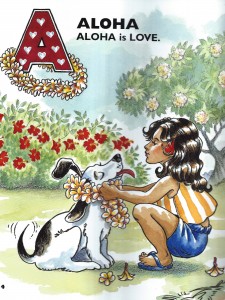 Linda Burton posting from Honolulu, Hawaii – “Aloha is love,” reads the first line of the children’s book entitled Let’s Learn the Hawaiian Alphabet (ISBN 1-59700-102-3, author Patricia Murray, illustrator Sharon Carter). We’ve asked everyone “What does “aloha” mean?” and every reply has been different. It could mean hello or goodbye, it could simply be a greeting, or it could mean “I love you.” Hmmm, a word to use with care! Every tour guide and every tourist spot has nudged the crowd to shout it out – A LOW HA! And we always fail the test. “Not very good!” they tell us, so we get a little louder. Still, a word has to have meaning to you when you say it, or it doesn’t sound like you really mean it, so ka-chung, the tour guide shakes his head and laughs. Kayla and I wanted to learn some real Hawaiian words, and use them properly. “Mahalo” we try to remember to say for “Thank you” and sometimes we get a smile in return. We’ve studied the street signs to get familiar with spelling, and Hawaiian names. “There are only twelve letters in the Hawaiian alphabet,” Kuka told us. Kuka was our soft-spoken driver on Saturday, delivering us safely to the Polynesian Cultural Center in Laie. Kuka went through the vowel sounds with us as we rode north; Vanna’s Wheel of Fortune would sound different here though the letters look the same. “U” is not “You,” it is “Oo” – we know not to say “you-ka-lay-lee” any more! But back to the book. » read more
Linda Burton posting from Honolulu, Hawaii – “Aloha is love,” reads the first line of the children’s book entitled Let’s Learn the Hawaiian Alphabet (ISBN 1-59700-102-3, author Patricia Murray, illustrator Sharon Carter). We’ve asked everyone “What does “aloha” mean?” and every reply has been different. It could mean hello or goodbye, it could simply be a greeting, or it could mean “I love you.” Hmmm, a word to use with care! Every tour guide and every tourist spot has nudged the crowd to shout it out – A LOW HA! And we always fail the test. “Not very good!” they tell us, so we get a little louder. Still, a word has to have meaning to you when you say it, or it doesn’t sound like you really mean it, so ka-chung, the tour guide shakes his head and laughs. Kayla and I wanted to learn some real Hawaiian words, and use them properly. “Mahalo” we try to remember to say for “Thank you” and sometimes we get a smile in return. We’ve studied the street signs to get familiar with spelling, and Hawaiian names. “There are only twelve letters in the Hawaiian alphabet,” Kuka told us. Kuka was our soft-spoken driver on Saturday, delivering us safely to the Polynesian Cultural Center in Laie. Kuka went through the vowel sounds with us as we rode north; Vanna’s Wheel of Fortune would sound different here though the letters look the same. “U” is not “You,” it is “Oo” – we know not to say “you-ka-lay-lee” any more! But back to the book. » read more
» posted on Saturday, June 23rd, 2012 by Linda Lou Burton
Pass It Forward
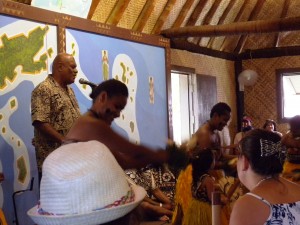 Linda Burton posting from Honolulu, Hawaii – “My 10-year-old son can recite our family genealogy for 17 generations back,” said our narrator. They’d found a place for Kayla and me on the back row of the jam-packed Fiji hut, and there we sat, bamboo sticks in hand, learning to chant and sing Fiji style. And, learning how to remember. The presentation at the Fiji settlement in the Polynesian Cultural Center was titled “History through Chants & Dance” and we’d just been taught how, as a group, to beat out rhythms, “one-two one-two-three” then “one-two-three-four” fast and slow, stop; then a call to us, “moo-oo” then our response “mai-ii” and repeat; somehow the roomful of us managed to do this together; and somehow, the feel of it began to stick in our memories. I know there’s a scientific explanation for what happens in the brain when rhythms and sounds take on a consistent pattern; but overall, it seemed to be the joy of it that took hold. Yet I was startled by that last remark. Seventeen generations? » read more
Linda Burton posting from Honolulu, Hawaii – “My 10-year-old son can recite our family genealogy for 17 generations back,” said our narrator. They’d found a place for Kayla and me on the back row of the jam-packed Fiji hut, and there we sat, bamboo sticks in hand, learning to chant and sing Fiji style. And, learning how to remember. The presentation at the Fiji settlement in the Polynesian Cultural Center was titled “History through Chants & Dance” and we’d just been taught how, as a group, to beat out rhythms, “one-two one-two-three” then “one-two-three-four” fast and slow, stop; then a call to us, “moo-oo” then our response “mai-ii” and repeat; somehow the roomful of us managed to do this together; and somehow, the feel of it began to stick in our memories. I know there’s a scientific explanation for what happens in the brain when rhythms and sounds take on a consistent pattern; but overall, it seemed to be the joy of it that took hold. Yet I was startled by that last remark. Seventeen generations? » read more
» posted on Saturday, June 23rd, 2012 by Linda Lou Burton
Want Me To Jump?
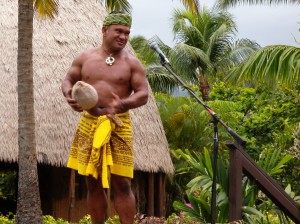 Kayla Shumate, age 10, traveling with grandmother, posting from Honolulu, Hawaii—G mom and I are at the Polynesian Cultural Center, sitting on a wooden bench watching the Samoa tribe show us clapping differences. A new man comes up and is making us laugh already. I knew I was going to enjoy this. He first shows us how to crack a coconut. He rips it open with his bare hands. He shows us the tiny face inside. He picked up a rock and banged it on the coconut. It cracked in two. He called up a kid in a red shirt, and shared the coconut with him. The host said “ugh disgusting.” We all laugh with tears in our eyes. After the laughter calmed down he showed us how to make fire. He got a long thin stick. He broke it in ¾ and ¼. He scraped the two sticks together and smoke came up from the two. He picked up dry grass and put it up against the two sticks. Then fire rose from the burning dry grass. He pointed to a man standing next to a tree and said “This man will show you how to climb a palm tree.” He climbed up the tree like Spider Man. When he reached the top he asked “Want me to jump?” » read more
Kayla Shumate, age 10, traveling with grandmother, posting from Honolulu, Hawaii—G mom and I are at the Polynesian Cultural Center, sitting on a wooden bench watching the Samoa tribe show us clapping differences. A new man comes up and is making us laugh already. I knew I was going to enjoy this. He first shows us how to crack a coconut. He rips it open with his bare hands. He shows us the tiny face inside. He picked up a rock and banged it on the coconut. It cracked in two. He called up a kid in a red shirt, and shared the coconut with him. The host said “ugh disgusting.” We all laugh with tears in our eyes. After the laughter calmed down he showed us how to make fire. He got a long thin stick. He broke it in ¾ and ¼. He scraped the two sticks together and smoke came up from the two. He picked up dry grass and put it up against the two sticks. Then fire rose from the burning dry grass. He pointed to a man standing next to a tree and said “This man will show you how to climb a palm tree.” He climbed up the tree like Spider Man. When he reached the top he asked “Want me to jump?” » read more
» posted on Friday, June 22nd, 2012 by Linda Lou Burton
The Shopping Isle
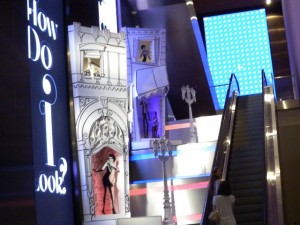 Linda Burton posting from Honolulu, Hawaii – “What did you buy?” is the question most often asked in Honolulu, frequently followed by “How do I look?” In case you think most people come here to lie on the beach in the peaceful shade of the palm trees, you are wrong. More people come to Honolulu to shop. High-end merchandise costs less in Honolulu than it does in Japan, we were told. The Waikiki Trolley Pink Line, departing every 10 minutes for a 16-point Stop and Shop run, has special Japanese language trolleys; in fact on every trolley signs give information and directions in both English and Japanese. The Aussies and the Mainlanders do their fair share of shopping too; if
Linda Burton posting from Honolulu, Hawaii – “What did you buy?” is the question most often asked in Honolulu, frequently followed by “How do I look?” In case you think most people come here to lie on the beach in the peaceful shade of the palm trees, you are wrong. More people come to Honolulu to shop. High-end merchandise costs less in Honolulu than it does in Japan, we were told. The Waikiki Trolley Pink Line, departing every 10 minutes for a 16-point Stop and Shop run, has special Japanese language trolleys; in fact on every trolley signs give information and directions in both English and Japanese. The Aussies and the Mainlanders do their fair share of shopping too; if 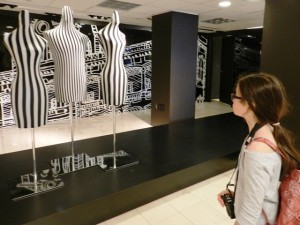 you aren’t toting a shopping bag, you are considered to have wasted your day. Temptation doesn’t miss a beat; the ticket office for the trolley line is in the DFS Galleria, once of the glitziest shopping arenas you are likely to see in a lifetime. That’s where they sell “luxury brand-name products duty-free.” “Wow” was what granddaughter Kayla said at the sight of the high-tech mod display by the escalator. “Let’s check it out.” » read more
you aren’t toting a shopping bag, you are considered to have wasted your day. Temptation doesn’t miss a beat; the ticket office for the trolley line is in the DFS Galleria, once of the glitziest shopping arenas you are likely to see in a lifetime. That’s where they sell “luxury brand-name products duty-free.” “Wow” was what granddaughter Kayla said at the sight of the high-tech mod display by the escalator. “Let’s check it out.” » read more
» posted on Friday, June 22nd, 2012 by Linda Lou Burton
Something Fishy at the Dance
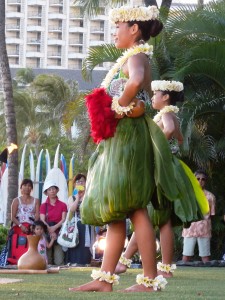 Kayla Shumate, age 10, traveling with grandmother, posting from Honolulu, Hawaii—G mom and I went to a hula dance show at Kuhio Beach Park last night. I brought my Hello Kitty towel with me so we could sit on the grass. The music players were playing Hawaiian music and it sounded nice. There were two hula dancers wearing skirts made of tea leaves. First they danced with the uliuli. Uliuli is feathered gourd rattles. The next one was the puili. Puili is bamboo rattles. The final one was ipu. Ipu is a hollow gourd used sort of like a drum. The host told all the newcomers to Hawaii to raise their hands so I raised mine. He said for all the newcomers to come up to the stage. We were going to learn how to hula! » read more
Kayla Shumate, age 10, traveling with grandmother, posting from Honolulu, Hawaii—G mom and I went to a hula dance show at Kuhio Beach Park last night. I brought my Hello Kitty towel with me so we could sit on the grass. The music players were playing Hawaiian music and it sounded nice. There were two hula dancers wearing skirts made of tea leaves. First they danced with the uliuli. Uliuli is feathered gourd rattles. The next one was the puili. Puili is bamboo rattles. The final one was ipu. Ipu is a hollow gourd used sort of like a drum. The host told all the newcomers to Hawaii to raise their hands so I raised mine. He said for all the newcomers to come up to the stage. We were going to learn how to hula! » read more
